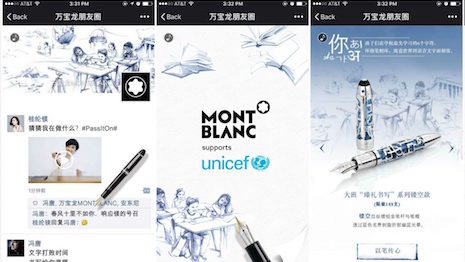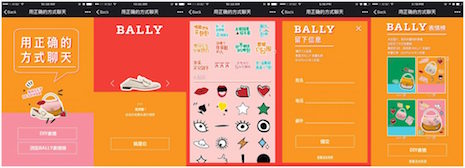- About
- Subscribe Now
- New York,
April 27, 2017

 This interactive campaign by Montblanc is part of the brand's global collaboration with UNICEF
This interactive campaign by Montblanc is part of the brand's global collaboration with UNICEF
By Yiling Pan
Since our last WeChat campaign roundup, luxury brands have been maintaining a strong presence on China’s headliner social media platform.
Big brands including Longchamp, Chanel and Montblanc have been coming up with creative initiatives that use the diverse features enabled by the WeChat application to nurture a new following and engage with existing users.
The following is a roundup of some of the latest WeChat marketing case studies from luxury brands in China of which WeChat marketers need to be aware.
1. WeChat x Mini App: Longchamp
Longchamp became the first luxury brand in China to use WeChat’s “mini apps,” when on April 21, the French fashion house set up two mini programs to celebrate its 70th anniversary. One functions as an ecommerce platform, while the other works as a city guide that provides users with a curated selection of tourist and dining spots to stop at in Shanghai.
 Longchamp's mini app on WeChat
Longchamp's mini app on WeChat
The concept of the first mini-app, which offers an online ordering and payment solution, is straightforward. Users can place their order and customize their purchases within the app, where they can use WeChat payment to track their shipment.
 Shoppers can buy Longchamp’s Le Pliage Badges on the brand’s newly launched WeChat mini app
Shoppers can buy Longchamp’s Le Pliage Badges on the brand’s newly launched WeChat mini app
The second mini app, called “ParisianING,” introduces places in the city that make Chinese fans of the brand feel like they are in Paris, such as French bakeries, florists and art galleries. The city has inspired Longchamp’s designs over the decades, thus the campaign aims to highlight the importance of Paris in the brand’s history to Chinese fans.
2. WeChat x Customer Relationship Management (CRM): Michael Kors
To promote its “Mercer” leather handbag and “Love” sweater, Michael Kors launched a video competition on WeChat April 14-24 in collaboration with the FACEU app in China.
 Michael Kors has partnered with photo-sharing app Faceu to host a video competition on WeChat
Michael Kors has partnered with photo-sharing app Faceu to host a video competition on WeChat
To enter, users need to upload Michael Kors-themed short videos on social media in exchange for a chance to win a handbag or a bottle of Michael Kors’ perfume.
Michael Kors’ campaign capitalizes on Chinese consumers’ penchant for selfies and the increasing popularity of FACEU, an augmented reality photo app complete with stickers and beautification filters.
Michael Kors worked with FACEU to create stickers that users can incorporate into their videos.
Through online promotion by Chinese celebrity Yang Mi, who also recently appeared in photoshoots for the brand in Vogue China, the campaign has attracted widespread attention from Chinese consumers.
3. WeChat x Moments: Montblanc
German luxury brand Montblanc launched a campaign called #PassItOn on WeChat as a part of its global philanthropic collaboration with the United Nations Children’s Fund (UNICEF) to support the right to write of kids in impoverished regions. This year marks the 13th year of the partnership with UNICEF.
The interactive campaign was designed to use Moments to spread the spirit of philanthropy through encouraging its followers to share the campaign information with their WeChat contacts.
Montblanc’s post starts off with a virtual Moments page where followers are able to read Moments posted by the brand’s ambassadors, including Gui Lunmei, a Taiwanese actress, Feng Tang, a popular Chinese author, and Shiliupo, an online fashion blogger.
The following pages offer the detailed information about the partnership (image 2) and a brief introduction to a range of limited products in the UNICEF collection (image 3).
Montblanc then invites followers to fill in the missing strokes of the character “love” to highlight the goal of the campaign: to spread love.
In the end, the brand urges viewers to share the campaign on their own Moments feed.
3. WeChat x Online to Offline (O2O): Chanel
From April 12-24, French luxury powerhouse Chanel opened Coco Café, a pop-up café-themed beauty store, in Shanghai. Visitors to the store could order a cup of coffee and some snacks provided by the brand while browsing beauty products and enjoying customized make-up services.
Coco Café has been a huge hit, attracting thousands of visits to the site every day.
Chinese social media was filled with photos taken by consumers in the store, who seemed undeterred by the long line snaking around the block.
VIP customers could avoid the long lines by reserving a spot on Chanel’s official WeChat account ahead of time.
4. WeChat x Gamification: Bally
Bally recently invited its WeChat followers to participate in an emoji competition, with the hope to engage with them in a creative and entertaining way while introducing its products.
Participants can DIY their own stickers and submit them to the official account with their personal information to enter the competition.
As shown on image 2, users need to choose a Bally product – either a pair of shoes or a handbag – to start making the emoji. They then have to choose elements out of a text and sticker library to personalize their work.
Users can also browse emojis created by other users and upvote the ones they like.
5. WeChat x Key Opinion Leaders: Mei.com
A recent WeChat campaign by Mei.com, the luxury ecommerce flash sales site backed by China’s tech giant Alibaba Group, was devoted to promoting its “Global Fashion Buyers Live Show.”
 Bally’s emoji contest encourages its followers to be creative and imaginative with its products
Bally’s emoji contest encourages its followers to be creative and imaginative with its products
The promotional WeChat article about the show posted five pictures and several hints about the fashion bloggers who were going to attend the event on April 16. Mei.com invited readers to guess the names of these fashion bloggers and post their answers in the comments section.
The first three people who figured out three names out of five correctly were awarded two tickets to the show.
On the day of the event, Chinese actress Song Jia, fashion stylist Han Huohuo, Weibo celebrity Wang Xiao, and Western fashion influencers Linda Tol, Taylor Tomasi Hill and Blair Eadie attended the event and shared their mix-and-match tips and style suggestions with Chinese consumers.
Victoria’s Secret’s supermodel Miranda Kerr also sent her greetings to Chinese fans in a pre-recorded video during the show.
Yiling (Sienna) Pan is luxury business and fashion reporter at Jing Daily, the leading digital publication on luxury consumer trends in China. Reproduced with permission.
Share your thoughts. Click here